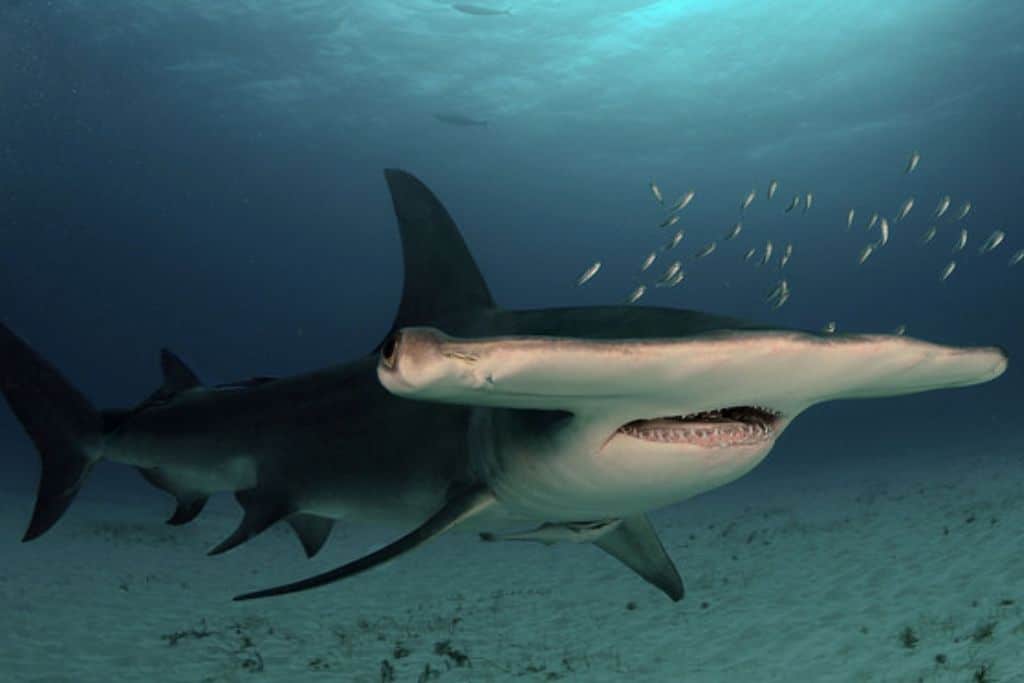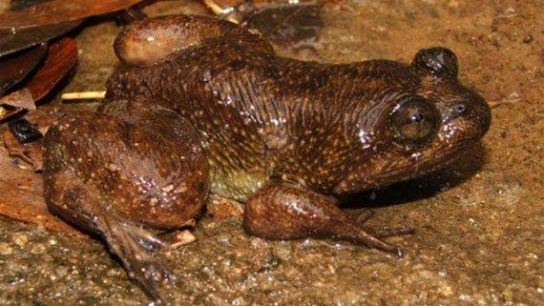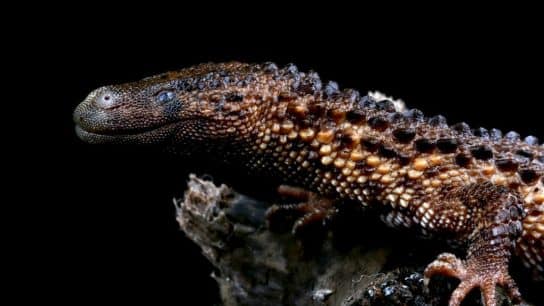The great hammerhead shark is one of nine species of shark belonging to the genus Sphyrna, all of which share a distinctively flattened and laterally elongated head structure. The species inhabits primarily coastal-pelagic, semi-oceanic environments and can be found in tropical, temperate seas worldwide. Regarded as an apex predator within coastal ecosystems, the great hammerhead shark is equipped with specialised, highly sensitive electroreceptor organs, known as “ampullae of Lorenzini”, that allow the animal to sense, amongst other things, electrical fields emitted by potential prey. Distinguishable as the largest species of hammerhead shark, the great hammerhead is particularly threatened by commercial fishing practices due to its sizeable fins, prized in Southeast Asian medicinal and culinary industries. The species is also highly susceptible to being caught as bycatch, with comparatively high at-vessel and post-release mortality rates as a result of pronounced behavioural and physiological stress.
—
Family: Sphyrnidae
Genus: Sphyrna
Species: Sphyrna mokarran
IUCN Status: Critically Endangered
Population: Unknown
1. Appearance
Although able to reach a length of 610 centimetres (20 feet) and a weight of 450 kilograms (992 pounds), the average great hammerhead shark measures approximately 400 centimetres (13.1 feet) and weighs 230 kilograms (507 pounds). The species has a stout, fusiform body shape, which reduces drag and allows for minimal energy expenditure when swimming, and is covered in dermal denticles: small V-shaped, teeth-like scales that further decrease drag and turbulence, enabling the shark to swim faster and more quietly. Its dorsal surface is dark brown to light grey or olive, whilst its ventral side is white or cream-coloured. Juveniles can be distinguished by a dusky-coloured second dorsal fin tip, which is typically uniform in colour in adults. The dorsal and pelvic fins of great hammerhead sharks are markedly tall and falcate, and their teeth are strongly serrated. The key distinguishing feature of the great hammerhead shark is the nearly straight anterior margin of its cephalofoil (hammer-like head) as well as the prominent median indentation seen in adults.
The distinctive shape of cephalofoils has long been the subject of scientific debate. This unique adaptation is thought to serve numerous purposes, however as the size, shape and morphology of cephalofoils vary amongst hammerhead shark species, they most likely developed as a result of evolutionary pressures specific to each species and their ecological background, and thus each serve a distinct function. The flattened, elongated structure of cephalofoils has been shown to act as a hydrodynamic bow plane, giving hammerhead sharks enhanced manoeuvrability and thus allowing them to quickly raise or sharply turn their head with stability. Although not definitively proven, some have speculated that the wide distance between the nostrils of hammerhead sharks allows the species to locate prey more efficiently when quickly swimming into an odour patch at an angle, moving in the direction of the nostril that first detects the scent.

Head morphology of all species in the Sphyrnidae family (Line drawings modified from Compagno, 1984).
The distance between the eyes of hammerhead sharks has also been proven to provide the animals with better binocular vision, with a much wider lateral field of view and increased anterior depth perception. This enables hammerhead sharks to track fast-swimming prey with a much greater level of accuracy than sharks with close-set eyes. The widened underside of cephalofoils further allows hammerhead sharks to have a higher concentration electroreceptor organs, or ampullae of Lorenzini, at their disposal for detecting electrical signals from potential prey. Lastly, great hammerhead sharks have been observed utilising the antero-ventral portion of their heads to ram and pin prey, such as stingrays, to the ocean floor whilst biting into their pectoral fins. It is unknown whether this type of prey handling behaviour is unique to the great hammerhead, as very few instances of hammerhead predation have been observed.
In a study conducted by the University of Colorado at Boulder in 2010, professor Andrew Martin theorised that the ancestor of all hammerhead sharks appeared abruptly approximately 20 million years ago, and was as large as some contemporary species. The cephalofoils of hammerheads then underwent divergent evolution in different lineages of time, becoming smaller in size, due to selective environmental pressures. In sacrificing size or locomotive advantages, smaller hammerhead species gained heightened visualisation abilities and energy for reproductive activities. Larger species retained a high concentration of electrical sensors, detecting extremely weak electrical emissions and triangulating on their prey.
2. Diet
The great hammerhead shark is an opportunistic feeder, consuming a wide range of prey that includes cephalopods, such as octopus and squid, crustaceans, invertebrates, bony fish, and other sharks. However, the species have shown a preference for stingrays and other batoids, as well as groupers and catfish. They have been observed with stingray and catfish barbs protruding from their mouths, indicating that the species is immune to stingray and catfish venom. When food is scarce, great hammerheads sharks are believed to be cannibalistic, consuming their own species if need be. Due to their large size, the species is regarded as an apex predator and is not preyed upon by other marine animals.
The great hammerhead shark feeds mostly at dusk, remaining close to the ocean floor. In addition to the species’ heightened sense of smell and sight, highly-sensitive electroreceptive organs (ampullae of Lorenzini) are distributed across the underside of the hammerhead shark’s cephalofoil, observable as small gel-filled pores that connect to nerve receptors at the base of the dermis, which enable the animal to detect electrical signals emitted by prey buried under sand. These sensory organs further allow hammerhead sharks to sense temperature changes in the water column, as well as to sense the Earth’s electromagnetic field for homing and migration.
3. Habitat & Behaviour
Great hammerhead sharks are a circumtropical species residing in costal temperate waters, typically above 20° C, from latitudes of 40°N to 31°S. Although occasionally observed at depths of up to 300 metres, great hammerhead sharks are usually found at depths of approximately 80 metres, above continental shelves, island terraces, in coral reefs and lagoons. Solitary by nature and highly mobile, some populations of the species seasonally migrate polewards in search of cooler waters during the summer months, whilst others are believed to be residential populations with seasonal incursions into colder waters due to range expansions (and thus, not true migrations). A study tracking the migration of a great hammerhead shark revealed that the animal had travelled a minimum distance of 1200 kilometres in 62 days.
Great hammerhead sharks have a faster growth rate than other species under the genus Sphyrna, reaching maturity between the ages of five and nine years. Females typically reach maturity at a length of 210 to 300 centimetres, whilst males attain maturity at the relatively smaller size of 187 to 269 centimetres. However, studies conducted in South Africa suggest the possibility of geographical differences in maturity sizes, as 50% of great hammerhead sharks in the region were documented as reaching maturity at distinctively larger sizes, with females at 337 centimetres in length and males at 309 centimetres. The species is believed to have a life expectancy of 42 to 44 years or longer.
Similarly to other hammerhead shark species, female great hammerhead sharks are viviparous, giving birth to live young, with nutrition for developing embryos emanating from a yolk-sac placenta. After a gestation period of 10-11 months, birthing occurs during the late spring or summer in the northern hemisphere, between October and November off eastern Australia, and between December and January off northern Australia. Litter sizes vary from six to 42 pups, each measuring between 50 and 70 centimetres in length. The species breeds only once every two years, making it vulnerable to depletion and reducing the likelihood of recovery from overexploitation. Pups and juveniles are usually found in shallow costal, inshore waters and are preyed upon by larger species of sharks, including fellow great hammerheads.
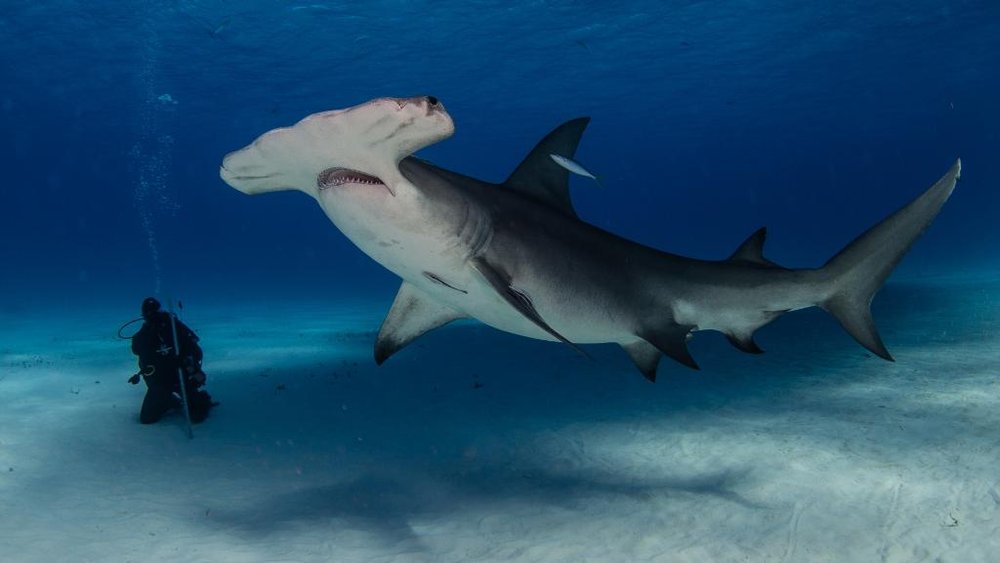
Great hammerhead shark in the Bahamas (Image by Jim Abernethy for Shark Allies).
4. Ecosystem Services
As an apex predator, the great hammerhead shark plays a crucial role in maintaining balance within coastal marine ecosystems. By preying on a wide range of species belonging to lower trophic levels, the great hammerhead sharks aids in maintaining healthy levels of species density and diversity within its environment. Following the process of natural selection, great hammerheads further consume diseased or injured marine animals, thus ensuring that individuals with unfit genes are not able to reproduce. If the extinction of the great hammerhead shark is not prevented through the enactment of effective conservation measures, it will inevitably have vastly negative impacts on costal ecosystems worldwide.
5. Threats
Despite the general lack of data on current population trends of great hammerhead sharks, the well-documented existence of illicit shark fin markets, the assumed under-reporting of incidental bycatch by commercial fishing vessels, and a classification of “Critically Endangered” under the International Union for Conservation of Nature (IUCN) Red List since 2019, the current level of protection awarded to great hammerhead sharks under national and international legislation is far from adequate. With recent studies further revealing historic population declines, high levels of inbreeding and alarmingly low levels of genetic diversity in the species, the threat of extinction they face will continue to grow unless effective conservation and protection measures are put in place.
Great hammerhead sharks are fished both commercially and recreationally, with a high financial value ascribed to their large fins. Whilst their meat is typically not consumed, incidents of endangered hammerhead shark species being caught as bycatch in South Africa and later packaged and sold to countries such as Australia with a label of ‘flake’, ‘pearl fillet’, ‘boneless fillet’ or ‘monkfish’ have been reported. Shark liver oil is utilised in the production of vitamins, carcasses are sold as fishmeal, and their hides are used for leather. Nevertheless, the main product the species is targeted for is its fins, as they comprise a significant proportion of the fin trade and are one of the preferred species for shark fin soup. Approximately 4% to 6% of the fins imported in Hong Kong have been found to emanate from great, scalloped and smooth hammerhead sharks, with scientists estimating that 1.9 million to 4 million sharks of these species are harvested each year for their fins.
You might also like: Hong Kong’s Distressing Role in the Global Shark Finning Trade
Since the great hammerhead shark is only protected under Appendix II of the Convention on International Trade in Endangered Species of Wild Fauna and Flora (CITES), it is not considered to be threatened with extinction and thus allows the species to be commercially fished and traded internationally by fisheries with a CITES permit. Even though the Australian government admittedly possesses limited data with regards to global and local stocks of great hammerhead sharks, the capture of 100 tonnes of great hammerhead sharks per year was found to be non-detrimental to species’ survival and is thus legal within the country. Due to their migratory nature, fisheries are also able to illegally hunt for the species in international waters, where fewer patrols occur.
Great hammerhead sharks are popular with recreational fishermen, particularly in Florida where legislation regarding the capture of the species is vague and often unenforced. Since hammerheads have been described as putting up an exciting fight, requiring two or three hours of reeling to be caught, they are often the target of competitions hosted by shark fishing clubs. Although such organisations claim that they abide by the practice of “catch and release”, hammerhead sharks are one of the most physiologically fragile species of shark and thus have extremely high post-capture mortality rates.
Hammerhead sharks are further targeted in shark culling programs along beachfronts for the protection of beachgoers. In Australia, shark nets and drumlines are placed in the ocean off the coast of 51 beaches between New South Wales and Queensland every year. Targeting species which are considered to be a potential threat to swimmers, the nets are placed in the bottom half of the water column and are specifically designed to keep shark populations away from the beach. However, rather than deter the animals, approximately 10,000 hammerhead sharks have been fatally entangled in these nets since the 1930s, with the figure assumed to be far higher due to failures in reporting and the disregard for pups in the wombs of deceased females. These lethal nets also catch dolphins, manta rays, and sea turtles. There have been no reports of human fatalities involving hammerhead sharks anywhere in the world. General misconceptions depict the animals as aggressive and dangerous due to their size, however the species are generally disinterested in humans.
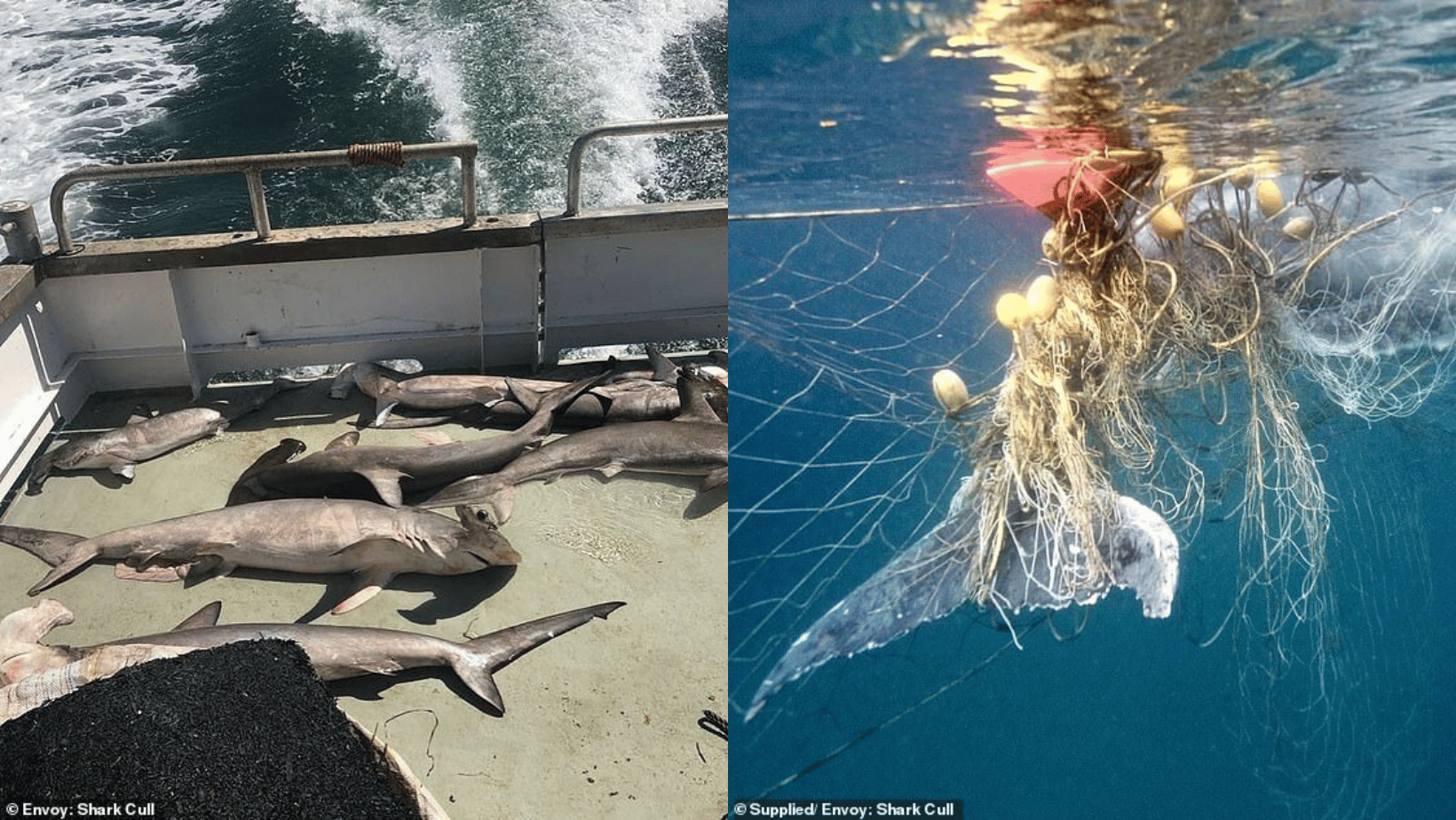
Approximately 10,000 hammerhead sharks have been fatally entangled in shark nets along the East coast of Australia since 1930 (Images courtesy of Envoy: Shark Cull).
Although commonly claimed that great hammerhead sharks are not targeted by the majority of commercial or small-scale fishing vessels, the species is regularly caught as bycatch throughout tropical regions with longlines, bottom trawling nets, hook-and-lines, gillnets and purse seine nets. However, as the custom of under-reporting bycatch is common throughout the commercial fishing industry, and due to the fact that fishermen continuously fail to identify the specific species of hammerhead shark incidentally caught, quantifying historical trends in great hammerhead shark population declines related to commercial, small-scale and recreational fisheries is extremely difficult. In India, landings of elasmobranchs fell from 75,262 tons in 1998 to 42,117 tons in 2018. While this may appear to be the result of improved management initiatives and bycatch reduction strategies, India’s constant increase in fishing efforts indicates the decline in bycatch actually reflects the extreme exploitation of elasmobranch populations in the region.
In South Africa, demersal fisheries have been observed utilising bottom-longlines along the boundaries of the De Hoop Marine Protected Area to catch small species of sharks, which inevitably lure larger predators, such as hammerhead sharks, and result in their incidental capture. Due to the aforementioned high financial value of hammerhead shark fins, these appendages are typically removed whilst the shark remains alive and the fatally injured animal is returned to the ocean without being recorded as bycatch. Although the US, Australia and the European Union have adopted bans on shark finning to prevent this practice, the sheer lack of regulatory measures and demand for accountability allow this barbaric custom to continue.
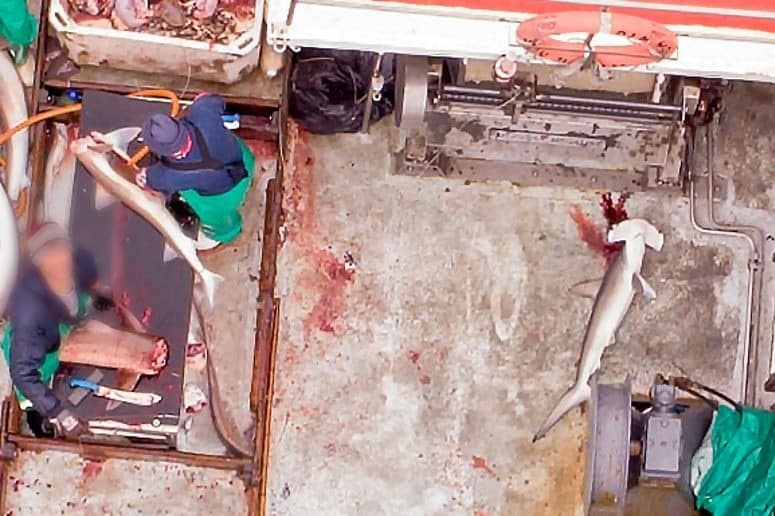
Drone footage taken by cage dive operator and wildlife photographer Chris Fallows in South Africa (Image courtesy of Sharkfreechips.com).
Even if fishermen were to receive adequate training on efficient, ethical methods of bycatch release, hammerhead sharks have been shown to suffer a post-capture mortality rate of 90% (the highest amongst shark species) due to the severe psychological stress they endure. Appearing to have a stronger fight-or-flight response than other species of sharks, approximately 56% of captured hammerhead sharks perish at-vessel when captured through bottom-longlines, with those released typically suffering from fatal or long-lasting physical and psychological injuries. The reckless use of purse seine nets have been shown to cause a mortality rate of 100% for the closely-related scalloped hammerhead shark. Due to this inherent vulnerability to stress-induced post-capture mortality, hammerhead sharks deserve greater attention in the development of sustainable fishing practices and the establishment of marine protected areas.
In January 2023, scientists analysed the chromosome-level genome assemblies of two species, the great hammerhead shark and the endangered shortfin mako shark (Isurus oxyrinchus), in an attempt to derive estimates of heterozygosity, inbreeding, and demographic history. Whereas heterozygosity provides an indication of the species’ standing genetic variation, reflecting their ability to adapt to changing environments and their vulnerability to low reproductive efficiency, historical demographic reconstructions can link changes in effective population size to various ecological factors (such as environmental shifts) and thus provide predictions on the effects of current and future environmental changes. Despite the importance of conservation genomics in the creation of effective conservation strategies, especially given the continuing advancement of sequencing technology, the genomic study of elasmobranchs (sharks, rays, skates, sawfish) had been largely neglected until now.
The results of the study revealed low genetic diversity and signs of inbreeding in great hammerhead sharks, both of which indicate that the species may be less resilient to adapting to our rapidly changing climate. Although scientists are not yet certain of the effects inbreeding has on shark populations, findings from wolves and cheetahs demonstrate that problematic traits often appear over time, reducing the fitness of populations through lower growth rates, a higher frequency of hereditary diseases, and higher mortality rates. This is particularly concerning given the finding that great hammerhead sharks have experienced drastic population declines over the last 250,000 years. The species is also considered to have naturally low fecundity due to relatively slow growth rates, its late onset of sexual maturity, and a biennial reproductive cycle, thus further reducing their ability to recover from significant reductions in populations.
With scientists estimating a global temperature increase of 1.5°C to 2°C in the next few decades, major climatic events and shifts in environmental conditions pose an increasingly fatal risk for highly mobile marine mammals, such as the great hammerhead shark. Since most sharks are ectothermic, dependant on the temperature of external environments since they cannot generate their own body heat, changes in water temperatures may have significant consequences on prey availability and migratory patterns for the great hammerhead shark. Given the aforementioned findings of low genetic diversity and inbreeding in the species, the great hammerhead shark faces an increasing possibility of extinction without the implementation of effective population management and conservation strategies.
6. Conservation
Although the reduction of great hammerhead shark populations is difficult to quantify, scientists have utilised a precautionary approach and concurred that a global population decline of over 80% over three generation lengths (71.1 to 74.4 years) is most likely. Due to the inadequacy of current protections afforded to the species under national and international legislation, which fail to reflect the severity of the extinction risk hammerhead sharks currently face, there are a number of conservationists and NGOs dedicated to saving the species through education campaigns, advocacy, monitoring and research.
As aforementioned, great hammerhead sharks are protected under Appendix II of CITES and can therefore be traded internationally. Although exporters are required to acquire a permit based on findings that traded parts were sourced from legal and sustainable fisheries, regulating the trade is difficult given the the high financial value of hammerhead shark fins and the lack of monitoring surrounding bycatch and illicit fishing practices. The species is listed under the Western and Central Pacific Fisheries Commission as a ‘key shark species’, but catch limits have yet to be adopted. The General Fisheries Commission for the Mediterranean also banned the retention of great hammerhead sharks, however implementation by parties to the Barcelona Convention has been slow. The species is further listed under Appendix II of the Convention on Migratory Species (CMS), indicating that the species is regarded as having an unfavourable conservation status rather than under risk of extinction. Further demonstrating the general prioritisation of financial gain over wildlife conservation, in 2015 Australia submitted a reservation to the inclusion of great hammerhead sharks to the CMS due to the burden it would place on recreational fishermen who incidentally capture hammerhead sharks. The state claimed that domestic management arrangements would continue to protect the species in light of the reservation, yet great hammerhead sharks are not even listed under the Environment Protection and Biodiversity Conservation Act of Australia. In light of these legislative shortcomings, in 2019 the ICUN recommended that all great hammerhead shark retention and landings be prohibited whilst the global population is regarded as Critically Endangered, further urging the full implementation of bans dictated by international treaties.
In June 2022, the Centre for Biological Diversity submitted a petition urging the United States National Marine Fisheries Service (NMFS) to list the great hammerhead shark under the Endangered Species Act (ESA). The petition further requested the NMFS to designate crucial habitat essential to the continued survival and eventual recovery of the species as protected areas. The Centre referenced significant great hammerhead population declines reported globally, including an estimated abundance and biomass decline of 99.99% in the Mediterranean Sea, as well as the widely recognised issues surrounding bycatch, illegal fishing, habitat degradation, and climate change. Notwithstanding the multitude of specific threats faced by great hammerhead sharks, the Centre further held that the resemblance in appearance between great and scalloped hammerhead sharks, the latter of which is protected under the ESA, warrants the inclusion of both species under the Act since difficulties in differentiating the two could exacerbate the threat of extinction faced by scalloped hammerheads. Unfortunately, the NMFS rejected the petition, citing a lack of species-specific information on the effects of climate change, ocean acidification and coastal development on great hammerhead sharks.
“The Fisheries Service’s decision not to move forward with protecting the great hammerhead shark under the Endangered Species Act is disappointing and misguided,” said Kristin Carden, a senior scientist with the Center for Biological Diversity at the time. “This critically endangered species has suffered a global population decline of more than 80% over the past 70 years. The agency’s failure to protect great hammerhead sharks keeps them on the path toward extinction.” Since one of the primary reasons for the denial of the petition was a lack of sufficient data on the species, the Centre has stated that it will continue to monitor the great hammerhead shark and resubmit the petition in the future once more data becomes available for review.

Two hammerhead sharks in the Bahama Banks (Image courtesy of Dive Magazine).
Monitoring and scientific research initiatives, such as those employed by the Centre for Biological Diversity, are incredibly important for the protection of great hammerhead sharks since information on population sizes, distribution, migratory patterns, and catch data is severely lacking. This effectively prevents an appropriate assessment of the extinction risk the species faces from being made and provides governments an excuse to exclude the species from protective legislation at a national and international level. In a report released by the Marine Biodiversity Hub of Australia in 2015, the authors noted that great hammerhead sharks were encountered less frequently, yet it was unclear whether it was due to the species being less common in the region, a result of depletion, or an indication that suitable habitats were not well sampled. Shortage on such basic ecological data allows for the continued overexploitation of hammerhead sharks with limited accountability, since governments are able to justify harvesting the species and destroying its environment by failing to acquire accurate data on its population size and distribution in the region. By implementing additional measures for species identification on fishing vessels, such as observer programs or photographic records, scientists and conservationists would also be able to define catch composition (both targeted and as bycatch) at a level that would be useful for determining whether harvest quotas can still be considered non-detrimental to the survival of the species.
Species-specific bycatch data, as well as further research into critical habitats of hammerhead sharks and the spatio-temporal variation in their use of differing habitats, is also crucial for the creation of effective avoidance and minimisation strategies for fisheries. Very few bycatch reduction technologies have been developed for elasmobranchs, despite their incredibly high susceptibility to post-catch mortality, and lack of monitoring provides fishermen with the opportunity to extract the fins of endangered species and throw them back into the water without detection. Turtle Excluder Devices (TEDs) have been found to achieve a bycatch reduction rate of 55% for hammerhead sharks and 31% for the closely related bonehead shark, and the use of escape tunnels in pelagic trawl nets also saw a reduction of 55% in the capture of hammerheads. The identification of potential nursery and residency sites for great hammerhead sharks, which have been shown to exhibit philopatric behaviour, would also greatly assist in the creation of Marine Protected Areas (MPAs) and no-take zones where restrictions on urbanisation and fishing activities would prevent the further deterioration of key hammerhead shark habitats.
One study, conducted in 2020 on Indian fisheries, reviewed potential fishery management options for their technical effectiveness and socio-economic feasibility. Although spatio-temporal closures, net restrictions and the introduction of bycatch reduction devices were anticipated to be difficult to implement in the short term due to the potentially high impact on income for fishermen, the study suggested commencing with participatory monitoring to address crucial knowledge gaps in elasmobranch ecology, thus allowing for a holistic assessment of potential long-term bycatch management strategies. Designing a bottom-up approach to spatio-temporal closures and gear restrictions, if accompanied by eco-labelling schemes or compensation incentives for lost profits, could encourage the implementation of mitigation measures and ensure better compliance with regulations.
In Australia, organisation such as the Humane Society International are petitioning to halt the use of drum lines for the protection of beachgoers due to the frequency of marine life entanglement and mortality. “Drum lines were first introduced in the 1960s and, since then, there has been 60 years of progress in technology and our understanding of shark behaviour,” said Nicola Beynon, the head of campaigns for the Humane Society International, in an interview with The Guardian. “There are better ways to protect ocean users that don’t kill our marine wildlife.”
Lastly, garnering public awareness on the plight of great hammerhead sharks is essential for the protection of the species, as education campaigns on sustainable seafood options, the consequences of consuming shark fin, the importance of reducing marine pollution, and the potential impacts of advocacy and petitioning can make a great difference if implemented globally. In Hong Kong, WWF’s work to reduce demands for shark fin have shown promising results, with a 70% drop in imports over the past decade and a decrease in the quantity of shark fin retained in the city (the remainder being re-exported to countries such as Vietnam and mainland China). By encouraging communities and populations across the globe to develop an interest in marine wildlife, the protection of poorly-understood, overexploited species, and in advocating for stronger legislative protections to be afforded to critically endangered species, the implementation of effective management and conservation initiatives becomes increasingly achievable in the foreseeable future.
You might also like: Shark Liver Oil: The Beauty Industry’s Secret Ingredient
NGO Spotlight: Centre for Biological Diversity
The Centre for Biological Diversity is a nonprofit organisation that utilises scientific analysis, litigation, advocacy, media outreach and campaigning to mitigate the impacts of anthropogenic pressures on marine and terrestrial ecosystems and the species that depend on such environments to survive. As aforementioned, in June 2022 the Centre petitioned the United States National Marine Fisheries Service (NMFS) to place great hammerhead sharks under the protection of the Endangered Species Act. Although the petition was rejected, the Centre has continued monitoring the species in the hopes of resubmitting the appeal when sufficient evidence is collected to demonstrate the risk of extinction that great hammerheads face. The Centre has had success in shutting down the most destructive fisheries in the Pacific, securing critical habitat protection for a number of endangered species, petitioning for new water and air pollution regulations for plastic plants, requiring the Environmental Protection Agency to address the impacts of carbon dioxide on the ocean under the Clean Water Act, and campaigning for the removal of Arctic and Atlantic waters from the federal offshore oil-leasing program. Through such inspiring work, the Centre for Biological Diversity is holding governmental organisations accountable for the environmental degradation and species endangerment that has occurred over decades and is implementing strategies for conservation that will hopefully prevent the extinction of entire ecosystems.
What You Can Do To Help
- Opt for sustainable seafood. Although it is difficult nowadays to determine whether your seafood was caught ethically and sustainably, do your research ahead of time and find a few brands that you trust. Alternatively, you can take the opportunity to adopt a plant-based diet.
- Raise awareness and petition against the harvesting of hammerhead sharks, and against unsustainable fishing in general. Safeguarding the great hammerhead shark’s continued existence is greatly dependent on banning all hammerhead landings worldwide and reducing instances of hammerheads being caught as bycatch. Tell your friends, colleagues and neighbours about the species’ plight, and petition your government to ban the import of hammerhead shark products or seafood caught though unsustainable practices.
- Support a conservation group. There are numerous NGOs and local organisations that are currently raising awareness on the great hammerhead shark’s threat of extinction, advocating for greater protections to be afforded to the species through national and international legislation. Show your support by volunteering or donating to their cause.
If you want to learn more about endangered species, make sure to check out other articles from our Endangered Species Spotlight Series










